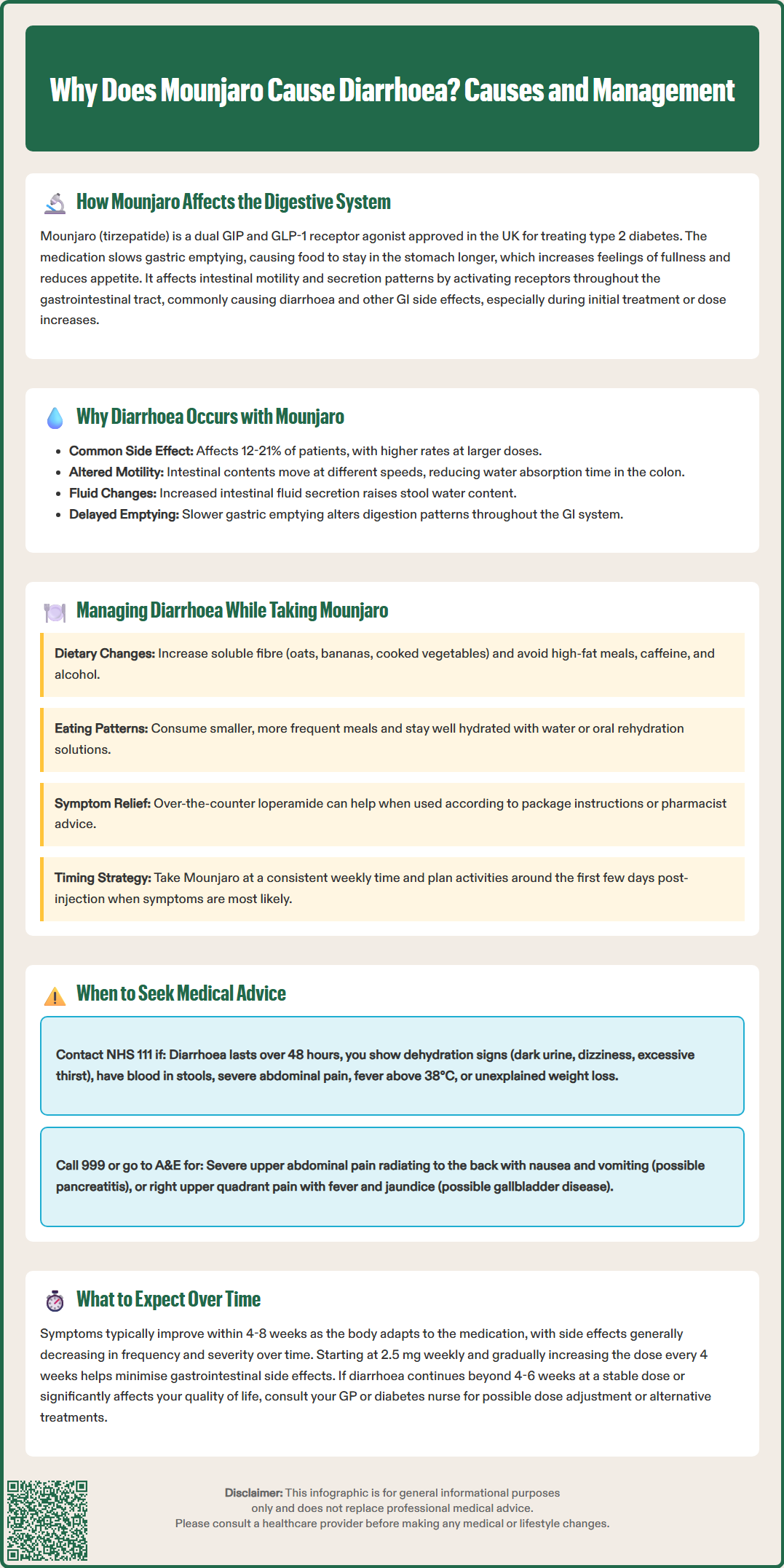LOSE WEIGHT WITH MEDICAL SUPPORT — BUILT FOR MEN
- Your personalised programme is built around medical care, not willpower.
- No generic diets. No guesswork.
- Just science-backed results and expert support.
Find out if you’re eligible

Mounjaro (tirzepatide) is a dual GIP and GLP-1 receptor agonist licensed in the UK for type 2 diabetes mellitus. Diarrhoea is one of the most commonly reported side effects, affecting approximately 12–21% of patients in clinical trials. Understanding why Mounjaro causes diarrhoea helps patients and healthcare professionals manage this gastrointestinal effect more effectively. This article explores the mechanisms behind this adverse reaction, practical management strategies, and when to seek medical advice during treatment.
Quick Answer: Mounjaro causes diarrhoea primarily through GLP-1 receptor activation, which alters gastrointestinal motility, delays gastric emptying, and affects intestinal fluid balance.
Mounjaro (tirzepatide) is a dual glucose-dependent insulinotropic polypeptide (GIP) and glucagon-like peptide-1 (GLP-1) receptor agonist licensed in the UK for the treatment of type 2 diabetes mellitus. Understanding how this medication interacts with the gastrointestinal system is essential for both patients and healthcare professionals managing treatment expectations.
Tirzepatide works by binding to GIP and GLP-1 receptors, which are involved in the action of naturally occurring incretin hormones. These receptors are present in the gastrointestinal tract, including the stomach and intestines. According to the MHRA/EMC Summary of Product Characteristics (SmPC), when Mounjaro activates these receptors, it triggers several physiological responses that extend beyond glucose regulation. One key effect is slowing gastric emptying, meaning food remains in the stomach for longer periods before moving into the small intestine. This delayed transit is thought to contribute to the feeling of fullness and reduced appetite observed with treatment.
GLP-1 receptor activation may also influence intestinal motility and secretion patterns. These effects on gastric emptying and intestinal function are believed to create conditions where gastrointestinal side effects, including diarrhoea, commonly occur, particularly during the initial weeks of treatment or following dose escalation. The UK SmPC recommends starting with a 2.5 mg weekly dose for 4 weeks, then gradually increasing in 2.5 mg increments at 4-week intervals to help minimise these gastrointestinal effects.
Diarrhoea is one of the most frequently reported adverse effects of Mounjaro. According to the MHRA/EMC SmPC, the incidence varies by dose, with higher rates observed at larger doses. In the SURPASS clinical trials, diarrhoea was reported in approximately 12-21% of patients, depending on the dose used.
Changes in gastrointestinal motility are thought to be a contributing factor. The effects of GLP-1 receptor activation on the gut may alter normal transit patterns in some individuals. When intestinal contents move through the bowel at a different rate than usual, and the colon has insufficient time to absorb water from digested food, the result can be loose or watery stools. This effect tends to be most pronounced when treatment is initiated or when doses are increased, as the digestive system requires time to adapt to the medication's influence.
Alterations in fluid balance in the intestine may also play a role. Changes in the normal patterns of fluid secretion and absorption in the intestinal lumen could potentially increase the water content of stool, leading to diarrhoea. The magnitude of this effect varies considerably between individuals, influenced by factors such as baseline bowel habits, dietary composition, and concurrent medications (particularly metformin, which can also cause diarrhoea).
Furthermore, the delayed gastric emptying caused by Mounjaro may contribute to changes in digestion patterns. Most patients experience improvement in gastrointestinal symptoms over time as physiological adaptation occurs, typically within 4–8 weeks of maintaining a stable dose. The EMA European Public Assessment Report (EPAR) notes that gastrointestinal adverse events generally decrease in frequency and severity with continued treatment.

Effective management of diarrhoea during Mounjaro treatment involves a combination of dietary modifications, lifestyle adjustments, and appropriate use of symptomatic treatments. Most cases are mild to moderate and can be successfully managed without discontinuing therapy.
Dietary strategies form the cornerstone of management:
Increase soluble fibre intake through foods such as oats, bananas, and cooked vegetables, which can help bulk stool and slow transit time
Avoid high-fat meals, as delayed gastric emptying combined with fatty foods may exacerbate gastrointestinal symptoms
Limit caffeine and alcohol, both of which can stimulate bowel activity and worsen diarrhoea
Stay well hydrated by drinking plenty of water throughout the day; oral rehydration solutions may be beneficial during episodes of frequent loose stools
Consider smaller, more frequent meals rather than large portions, which may be better tolerated given the medication's effect on gastric emptying
Identify and temporarily avoid potential trigger foods, such as spicy dishes, artificial sweeteners, or dairy products if lactose intolerance is suspected
Pharmacological management may be appropriate for persistent symptoms. Over-the-counter loperamide can be used for symptomatic relief, following package instructions or as advised by a healthcare professional. The NHS recommends not exceeding the maximum dose stated on the packaging and consulting a pharmacist if you're pregnant, have other health conditions, or are taking other medications.
Timing considerations are also important. Taking Mounjaro at a consistent time each week and planning around social or work commitments during the first few days post-injection may help patients manage symptoms more effectively.
If diarrhoea persists or is severe, discuss with your healthcare provider about possibly slowing the dose titration schedule or temporarily reducing the dose. During episodes of diarrhoea, follow NHS sick day rules if you take medications such as metformin, ACE inhibitors, ARBs, diuretics, NSAIDs or SGLT2 inhibitors, as these may need to be temporarily paused to reduce the risk of dehydration and acute kidney injury.
Whilst diarrhoea is a recognised and generally manageable side effect of Mounjaro, certain circumstances warrant prompt medical evaluation. Patients should be educated about red flag symptoms that indicate potentially serious complications requiring healthcare professional assessment.
Call NHS 111 or seek urgent medical attention if you experience:
Severe or persistent diarrhoea lasting more than 48 hours despite conservative management, particularly if accompanied by inability to maintain adequate fluid intake
Signs of dehydration, including excessive thirst, dark urine, dizziness, reduced urine output, or feeling faint when standing
Blood or mucus in stools, which may indicate intestinal inflammation or other pathology unrelated to the medication
Severe abdominal pain or cramping that is persistent or worsening, especially if localised to one area
Fever above 38°C accompanying diarrhoea, which could suggest infection
Unexplained weight loss beyond expected therapeutic effects, or inability to maintain nutrition
Attend A&E or call 999 if you experience symptoms of pancreatitis, such as severe upper abdominal pain radiating to the back, nausea, and vomiting. The MHRA/EMC SmPC identifies pancreatitis as a rare but serious adverse effect that requires immediate medical attention.
Also seek urgent medical advice if you develop right upper quadrant pain, fever, or yellowing of the skin/eyes, as these could indicate gallbladder disease, which has been associated with GLP-1 receptor agonists.
Routine consultation with your GP or diabetes specialist nurse is advisable if diarrhoea persists beyond 4–6 weeks at a stable dose, significantly impacts quality of life, or if you have concerns about medication tolerance. Your healthcare team can assess whether dose adjustment, temporary treatment interruption, or additional investigations are appropriate. In some cases, alternative glucose-lowering therapies may be considered if gastrointestinal side effects prove intolerable despite optimal management strategies.
Patients with pre-existing gastrointestinal conditions such as inflammatory bowel disease, irritable bowel syndrome, or previous bowel surgery should maintain closer monitoring and may require individualised management plans. The MHRA Yellow Card scheme allows reporting of suspected side effects, contributing to ongoing medication safety surveillance.
Diarrhoea from Mounjaro typically improves within 4–8 weeks as your body adapts to the medication at a stable dose. Symptoms are most common when starting treatment or increasing doses, and generally decrease in frequency and severity with continued use.
Yes, over-the-counter loperamide can be used for symptomatic relief of diarrhoea whilst taking Mounjaro. Follow package instructions and consult a pharmacist if you're pregnant, have other health conditions, or take other medications.
Contact your doctor if diarrhoea persists beyond 48 hours, you show signs of dehydration, notice blood in stools, experience severe abdominal pain or fever, or if symptoms significantly impact your quality of life despite management strategies.
All medical content on this blog is created based on reputable, evidence-based sources and reviewed regularly for accuracy and relevance. While we strive to keep content up to date with the latest research and clinical guidelines, it is intended for general informational purposes only.
DisclaimerThis content is not a substitute for professional medical advice, diagnosis, or treatment. Always consult a qualified healthcare professional with any medical questions or concerns. Use of the information is at your own risk, and we are not responsible for any consequences resulting from its use.